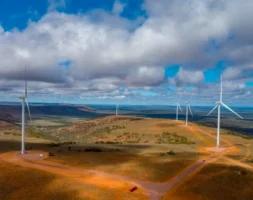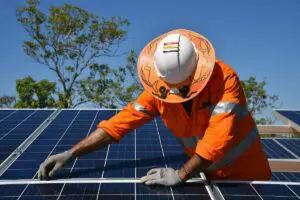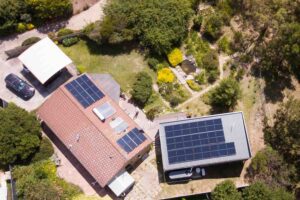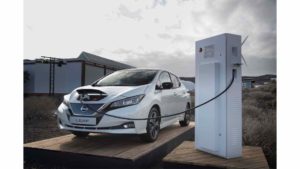The farm of the future could sell electricity as well as meat and crops, says Karin Stark, the author of a new report calling for government support for farmers spearheading a rural energy transition.
Stark envisions farmers becoming energy traders by exporting power generated on-farm, enabled by a modernised grid and new ideas around small scale power sales.
“This vision sees new ways of operating farming businesses and producing food with low cost energy, such as robotic dairies, fleets of electric tractors powered by on-farm renewables, and solar powered greenhouses,” she said during a webinar introducing the report Farm Powered.
“They could initiate mid-scale solar developments on their land and become traders of renewable energy, reshaping their role in rural areas and supporting their communities to access local power. enabled by a modernised distribution network. The farm enterprise of tomorrow really could be a multi income stream proposition.”
A shift to flexible dynamic operating envelopes, a model the Energy Security Board (ESB) is considering which would impose export limits when network capacity is reached rather than one blanket limit, would give farms like Stark’s NSW cotton operation with its 500kW solar array the ability to make money from exports.
Currently she says the array, necessary during summer for pumping huge amounts of water for irrigating cotton crops, is not connected to the local grid because of a local 30kW export limit.
“Right now we’ve got water flowing everywhere [due to heavy rain]. We can’t actually put that 500kW back into the grid to supply our community because of the export limit. I’m really interested in that payback period for farmers that can’t export the excess energy because of these export limits,” she says.
“It pushes out the payback period and you might be able to export that and help provide energy to your neighbours or trade or others in the local area.”
Both export income and subsidies to help farmers cover out-of-pocket set-up costs would allow them to offset the risk of spending thousands on a farm-scale solar array only for the next year to see floods, fires or pestilence destroy farm income.
Mixing energy generation and farming on site
Farms could be the new workhorses of the renewable energy transition, the report from Farmers for Climate Action argues, with the right policy settings.
Currently it’s impossible to say how many farming operations use renewable energy at all, because there is no data.
The report calls for an end to export limits and recommends creating mid-scale community and farmer ‘informal REZs’ which identify under-utilised hosting capacity in the network and encourage dispersed 1-5MW solar developments.
It also advocates for subsidies for batteries and to bring agricultural operations into the fold to work with organisations like the Australian Renewable Energy Agency (ARENA) and the Australian Energy Market Operator (AEMO).
Primarily, the report underscores the huge potential of agrivoltaics, the combination of energy generation with food and fibre production on the same land.
“Places like Japan, Germany, Denmark, they’ve been doing agrivoltaics growing high value crops under solar panels for many years,” Stark says.
“And there’s benefits to growing these crops because you get a higher soil moisture, so that reduces the need for irrigation. There was a study in Arizona in the US that showed that tomatoes grown under solar panels actually doubled in their yield.”
About 12 solar farms in Australia graze sheep under solar panels, allowing the developer to cut herbicide costs and farmers to benefit from fencing that locks out predators such as wild dogs.
Developers are beginning to plan for this kind of multi-use now at the earliest stages of designing a project, says co-author Andy Bray,
“Some industry players are starting to plan what the agricultural outcomes are going to be as well. One project is working on a fat lamb operation. They are looking at putting in all the infrastructure and assessing the irrigation and water at the same time as they install the solar farm,” he said.
Hyper local power possibilities
Microgrids could be a factor in future, supported by distribution network service providers (DNSPs) which look after the poles and wires and retailers that pay a higher feed-in-tariff to small supplies.
“More batteries in the network help shift exports to parts of the day when demand is high and hence attracts a higher value for feed-in-tariffs. With lower connection costs and quicker processing times, mid-scale renewables in the regions will flourish,” the report said.
Frequency Control Ancillary Services (FCAS) markets will create lucrative secondary revenue streams for farmers.
However, that is the future. Today, Stark says there are many problems with setting up rural microgrids.
The high physical cost of building one, questions around safety and reliability obligations if a farmer or a group of farmers were to own those poles and wires so they can share energy behind the metre, and the regulatory environment doesn’t support the sharing of energy.
“There’s even social risk. If there’s a group of farmers who have a set energy demand and one farmer decides they don’t want to be part of the microgrid anymore or they change what they’re growing, how does that impact the others? So there’s a lot of legal and social aspects that still need to be worked out,’ she said.
“It’s not that I don’t think it can happen in the future and it should happen, but at the moment it’s quite early days, particularly over the East Coast.”
Future industries
Bringing farmers into the renewable energy fold on a large scale could open the door to new, low cost industries.
Creating a distributed network of low cost, green urea manufacturers using farm inputs and renewable energy would give farmers access to higher prices in markets that are erecting climate-related trade barriers, says noted economist Ross Garnaut.
“There’ll be a lot of money in that in the zero emissions economy,” he said during the webinar.
“And so farmers who are able to show that they have access to an efficient supply chain will continue to have access to the highest price markets.”
The report suggests the federal government funds pilot small-scale renewable powered hubs that share infrastructure and supply a local region with products and services such as green ammonia to urea processing, not only reducing the cost of the critical farm commodity but also making it in a cleaner way.










